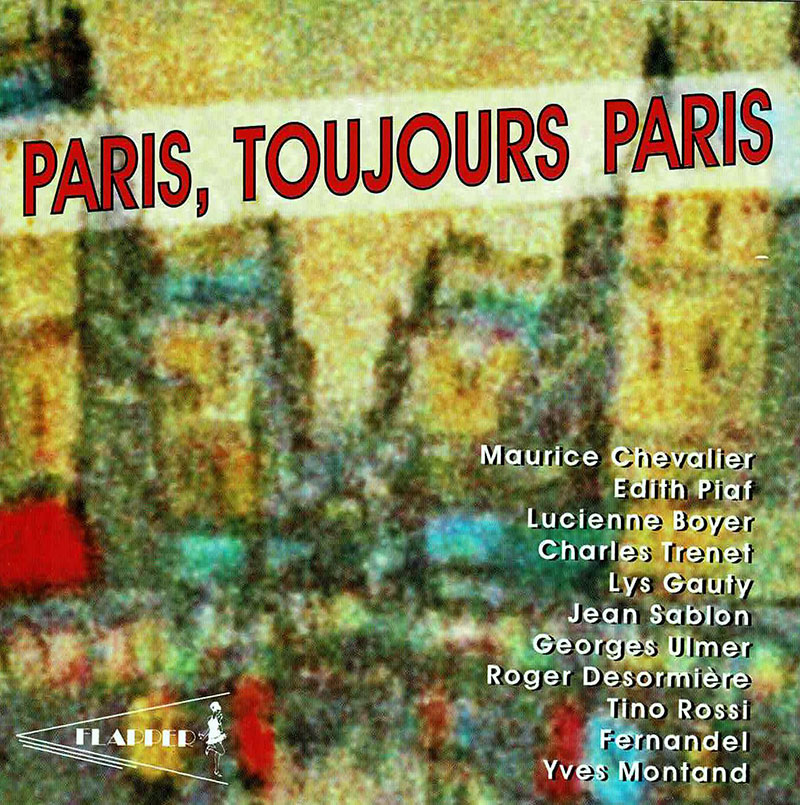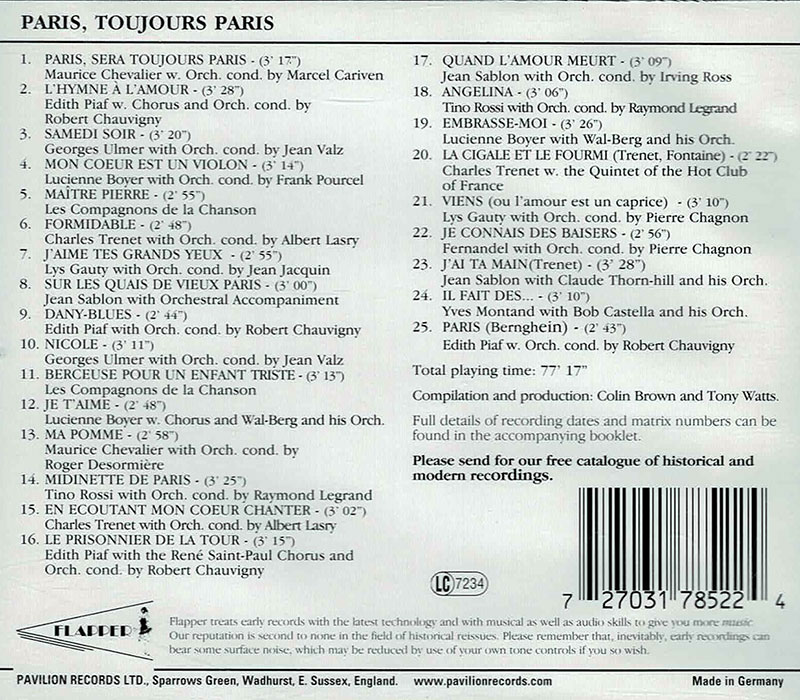Logowanie
Mikołaj - ten to ma gest!
Elton John, The Mamas & The Papas, Cat Stevens, Rod Stewart, Bobbie Gentry, Stevie Wonder, Engelbert Humperdinck
Memory Lane
Edycja Numerowana - 1000 egzemplarzy w skali światowej
RACHMANINOV, Eiji Oue, Minnesota Orchestra
Symphonic Dances / Vocalise
Best Recordings of 2001!!! NAJCZĘŚCIEJ KUPOWANA PŁYTA Z RR!
Karnawał czas zacząć!
Music of Love - Hi-Fi Latin Rhythms
Samba : Music of Celebration
AUDIOPHILE 24BIT RECORDING AND MASTERING
CHOPIN, LISZT, DEBUSSY, DVORAK, Gerhard Oppitz
Dances romantiques - A fantastic Notturno
Wzorcowa jakość audiofilska z Clearaudio
Winylowy niezbędnik
ClearAudio
Double Matrix Professional - Sonic
najbardziej inteligentna i skuteczna pralka do płyt winylowych wszelkiego typu - całkowicie automatyczna
Maurice Chevalier, Edith Piaf, Charles Trenet, Tino Rossi, Fernandel
Paris, toujours, Paris

- 1. Paris,Sera Tourjours Paris - MauriceC hevalier/Marcel Cariven Oberfeld/Willemetz 3:17
- 2. L'hymne A L'amour - EdithPiaf/Robert Chauvigny Monnot/Piaf 3:28
- 3. Samedi Soir - Georges Ulmer/Jean Valz Koger/Ulmer 3:20
- 4. Mon Coeur Est Un Violon -Lucienne Boyer/Frank Pourcel Laparcerie/Richepin 3:14
- 5. Maitre Pierre - LesCompagnons De La Chanson Betti 2:55
- 6. Formidable - Charles Trenet/Albert Lasry Trenet 2:47
- 7. J'aime Tes Grandes Yeux - Lys Gauty/Jean Jacquin Bixio/Trenchant 2:55
- 8. Sur Les Quais De Vieux Paris - Jean Sablon Erwin/Poterat 3:00
- 9. Dany-Blues-EdithPiaf/Robert Chauvigny Monnot/Piaf 2:44
- 10. Nicole-Georges Ulmer/Jean Valz Burgy 3:11
- 11. Berceuse Pour Un Enfant Triste - Les Compagnons De La Chanson Frachon 3:13
- 12. Je T'aime - Lucienne Boyer/Wal-Berg And His Orchestra Pills/Tabet 2:48
- 13. Ma Pomme - Maurice Chevalier/Roger Desormiere Bore l2:58
- 14. Midinette De Paris - Tino Rossi/Raymond Legrand Hume l3:25
- 15. En Ecoutant Mon Coeur Chanter - Charles Trenet/Albert Lasry Herpin 3:02
- 16. Le Prisonnier De La Tour - Edith Piaf/Rene Saint-Paul Chorus And Orchestra/Robert Chauvigny Blanche /C/I3:15
- 17. Quand L'amour Meurt-Jean Sablon/Irving Ross Cremieux/Millandy 3:09
- 18. Angelina - Tino Rossi/Raymond Legrand Fisher/L/R 3:06
- 19. Embrasse - Moi - Lucienne Boyer/Wal - Berg And His Orchestra Emer/Farge 3:26
- 20. La Cigale Et Le Fourmi - Charles Trenet/Quintet Of The Hot Club Of France Fontaine/Trenet 2:22
- 21. Viens(Oul'amour Est Un Caprice)-Lys Gauty/Pierre Chagnon Hely.Marc 3:10
- 22. Je Connais Des Baisers - Fernandel/Pierre Chagnon Manse/P/V 2:56
- 23. J'ai Ta Main - Jean Sablon/Claude Thornhill And His Orchestra Trenet 3:28
- 24. Il Fait Des - Yves Montand/Bob Castella And His OrchestraCheckler3:10
- 25. Paris - Edith Piaf/Robert Chauvigny Bernghein 2:42
- Maurice Chevalier - vocal
- Edith Piaf - vocal
- Charles Trenet - vocal
- Tino Rossi - vocal
- Fernandel - vocal
Is there a more enjoyable city in Europe to visit than Paris? In addition to the sheer beauty of the French capital and the joy of visiting some of its many restaurants or bars, it boasts a thriving arts scene with its superb galleries, concert halls and opera houses. Even to those who have been to Paris over the last few years, the French popular songs of the 'thirties and 'forties seem to evoke the unique atmosphere of the place in a most powerful manner. The present compilation is a star-studded compendium of music, lyrics and artists which will seemingly transport you across the Channel as you listen to it. And remember, it's much cheaper than a ticket on Eurostar! Our `cafe-concert' opens with a paean of praise to Paris from Maurice Chevalier, a performer who exemplifies the debonair, sophisticated French male. Following an early career breakthrough in Paris, Chevalier travelled to Hollywood in order to make a series of romantic films which turned him into an international star. His popularity dipped considerably following allegations made against him at the end of the War, but, by the late 'forties, he was, once more, in the ascendancy with his sparkling oneman shows and films including the musical `Gigi'. He is also to be heard in one of his biggest hits, Ma pomme (Track 13). Where much of Chevalier's music was light-hearted, Edith Piaf's artistry was of an emotional depth almost frightening in its intensity. A tragic personal life found expression in her singing of love found and love lost in such classics as L'Hymne a l'amour (Track 2). She sometimes displayed a lighter side to her music-making, but she was at her best in music reflecting her passionate nature. From her debut as a teenager until her early death in 1963, Piaf was, for many, the voice of France. Other examples here of her late `forties vocal prime are Dany-Blues (Track 9), Le prisonnier de la tour (Track 16) and the marvelously evocative Paris (Track 25). Although regarded as one of the paragons of French popular song, Georges Ulmer was actually a Dane, born in Copenhagen and he first made his name performing Gallic material in his home country. He finally settled in Paris just after the last War. That he was a most stylish vocalist is apparent in two numbers which he had a hand in writing, Samedi soir (Track 3) and Nicole (Track 10). A native Parisian, Lucienne Boyer first enjoyed success in cabaret at the age of sixteen in 1917, becoming a star in the 'twenties. She was another French artist to become popular in America, in her case through appearances on Broadway. Her recording career began in 1926, after which she clocked up many hits in France and starred in several feature films. Boyer continued to appear in public until the late 'sixties. A gentle, warm, intimate singing style is apparent in Mon coeur est un violon (track 4), , Je t'aime (track 12) and Embrasse-moi (Track 19); she was a wonderfully romantic vocalist. Formed in 1941, initially as part of a movement which asserted French nationalism in opposition to the invading German forces, Les Compagnons de la Chanson was an a cappella singing group with a uniquely Gallic flavour which owed nothing at all to the close harmony aggregations that were so popular in the States during the 'forties and 'fifties. Performing both traditional material and contemporary songs, its members enjoyed a fruitful alliance with Edith Piaf who both recorded and toured with the group on a regular basis. Maitre Pierre (Track 5) and Berceuse pour un enfant triste (Track 6) were two of Les Compagnons' most-popular records in the late 'forties. One of the giants of the French musical scene, Charles Trenet excelled as songwriter, poet, actor and singer. In 1933 he formed a duo with Johnny Hess, before going solo three years later. Trenet, to begin with, specialised in manic impressions of Maurice Chevalier, but such a multi-talented man could not suppress his individuality for long. His fame spread via radio, then through a series of films. By the late 'forties he was of sufficient stature for his records to become hits all round the world and to be able to fill large venues, such as the famous `Olympia' in Paris, for his one-man shows. Formidable (Track 6), En ecoutant mon coeur chanter (Track 15) and la Cigale et la Fourmi (Track 20) show that, just as Trenet himself retained his youthful energy into old age, so his art is essentially timeless. Just like Piaf, Lys Gauty rose from an impoverished background to become a star. She too was un intensely emotional singer, but her style was more contained, less overt. Although she managed to perfect the difficult stage trick of having her eyes fill with tears while singing, Gauty was, in general, the most subtle of artists. In both J'aime tes grands yeux (Track 7) and Viens (on l'amour est un caprice) (Track 21) she manages to express considerable feeling without lapsing into bathos. In many ways Jean Sablon was the French equivalent of the popular American crooners such as Bing Crosby or Dick Haymes. He was good looking, full of charm while, in addition, he had that certain je ne sais quoi that distinguishes Gallic singers from their transatlantic counterparts. Beauty of voice was un added ingredient to the Sablon cocktail, together with a relaxed delivery that made Bing sound positively hyperactive in comparison. Sablon became un international star through the medium of his many recordings such as Sur les quais de vieux Paris (Track 8), Quand l'amour meurt (Track 17) and J'ai to main (Track 23). Each is a priceless souvenir of a cherishable entertainer. Tino Rossi was rather different from most of the names featured on this disc. He was born in Corsica and his voice was a light, lyric tenor. It was probably not substantial enough for operatic work, but, given a ballad, or a Neapolitan song to sing he could charm the birds from the trees. It took Rossi years of hard work to reach the top of his profession, but, by the mid-'thirties he was a major figure in French popular music with best-selling records and starring roles in films. He proved to be un excellent actor as well as a fine singer. Midinette de Paris (Track 14) and his French version of the American songAngelina (track 18) are representative of a singer who was popular throughout the world, but genuinely loved in France. Although Fernandel is primarily remembered for his horse-faced comic presence in more than 150 films, he was also a stage performer who played in the music halls as well as in un operetta specially written for him by Jean Manse. He was also a prolific recording artist with hundreds of sides to his credit. His vocal attributes may have been modest, but much of his unique personality comes across in the likes ofJe connais des baisers (Track 23). In the vanguard of the younger generation of French artists who really made an impact after the last War was Yves Montand. Cabaret appearances with Edith Piaf served to introduce him to a wide public which soon began to buy his records in large numbers. Montand carved out a notable film career in France, before being wooed by Hollywood where he starred in such box office hits as `Let's Make love' in which he starred with Marilyn Monroe and `On A Clear Day You Can See Forever' opposite Barbra Streisand. Towards the end of his life he gave a masterly display of character acting in the award-winning `Jean de Florette'. Recorded in 1945, Il fait des... (Track 24) is typical of his early style when his stage act combined eccentric dancing with comedy numbers and down-tempo ballads. Enjoy the music, sit back and imagine yourself in a small Parisian cafe as you listen to it. Best go easy on the wine though.......... (c) 2001 TONY WATTS





























